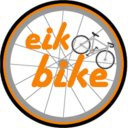On this page, we would like to briefly discuss the materials used in the development or production of designs at eik-bike.
It is important to note that the choice of the right filament depends on the specific requirements of the application. Factors such as printing temperature, bed adhesion, and susceptibility to warping are important for use in a reliable and cost-effective production of the designs. Mechanical properties, UV resistance, and resistance to solvents and outdoor temperatures in moderate latitudes determine, whether a material can be used in an eik-bike product.
PLA (Polylactic Acid): Properties:
PLA is a biodegradable polymer made from renewable resources such as corn starch or sugarcane. It is odorless and easy to print.
Advantages: Environmentally friendly, easy to print, biodegradable, widely used for 3D printing prototypes and art objects.
Limitations: Not as heat resistant as other filaments, not ideal for applications requiring high temperatures.
PLA is used at eik-bike due to its low price and ease of printing during the development phase. Printing times are short with PLA, and printing is less energy-intensive due to the low nozzle and bed temperatures. However, since PLA is relatively brittle and does not withstand UV radiation outdoors in the long term, it is not suitable for most outdoor applications.
PETG (Polyethylene Terephthalate Glycol):
Properties: PETG is a more durable and heat-resistant filament compared to PLA. It combines the advantages of PLA and ABS and offers good impact resistance.
Advantages: High transparency, good impact resistance, food safe, heat resistant.
Limitations: May be susceptible to stringing (threads between printed objects).
With a heated bed temperature of around 70°C, PETG can be reliably printed. Warping or poor bed adhesion are rarely a problem. Additionally, the products benefit from the aforementioned combination of hardness (close to ABS) and impact resistance. PETG is UV resistant and does not soften even on a hot summer day. As long as the surface is flawless, stringing can be removed in post-processing of the prints, for example, with a heat gun. PETG is used for many products at eik-bike.
Nylon / Polyamide (PA): Properties:
Nylon is a strong and flexible filament with high toughness. It is resistant to abrasion and chemicals.
Advantages: High toughness, flexibility, abrasion resistance, chemical resistance.
Limitations: Must be carefully dried to avoid moisture and often requires a heated print bed.
Due to the properties mentioned above, nylon is suitable for many mechanical applications. However, despite high print bed temperatures, loss of bed adhesion and warping during printing remain an issue with nylon. This increases the rate of failed prints and makes production material- and time-intensive. Furthermore, manufacturing dimensionally accurate designs with nylon is a challenge. At eik-bike Nylon is used for small components that need to be very flexible or primarily withstand tensile forces.
Fiber-reinforced Filament
(e.g., with carbon fibers or glass fibers):
Properties: Reinforced with fibers for increased strength and rigidity.
Advantages: Improved mechanical properties, higher strength.
Limitations: Can be more difficult to print, abrasive effect on nozzles.
By incorporating a fiber content into the aforementioned plastics, a kind of composite material is obtained. This changes the appearance and mechanical properties of the print. A matte finish is often achieved, which also comes with a rougher surface. The relatively short fiber fragments in these filament types protrude from one layer to the next during printing. This improves the adhesion between layers (a typical weak point of FDM 3D printing) and also reduces warping of the print during cooling. Due to higher material costs and a more complicated printing process, fiber-reinforced filaments are used at eik-bike when special mechanical stresses and requirements are expected for products.
